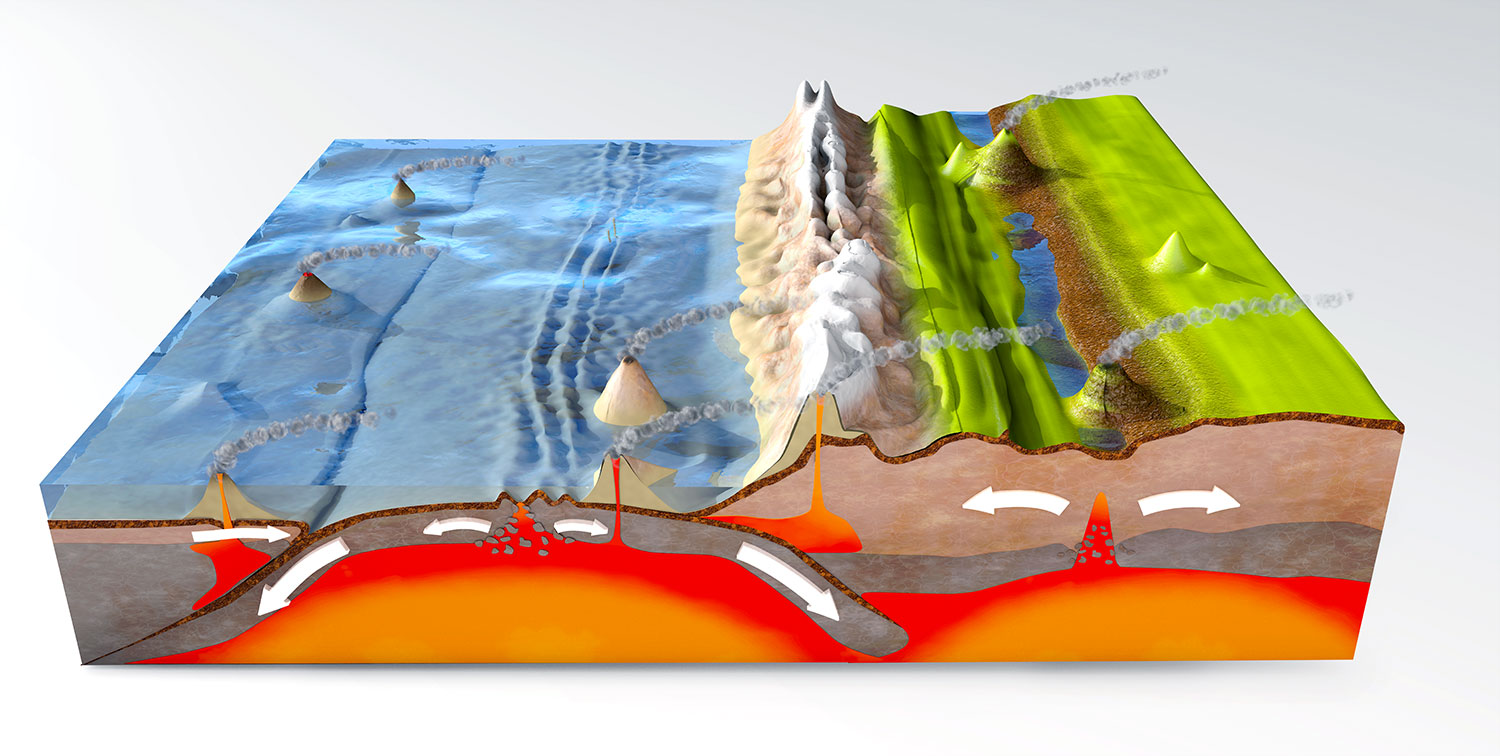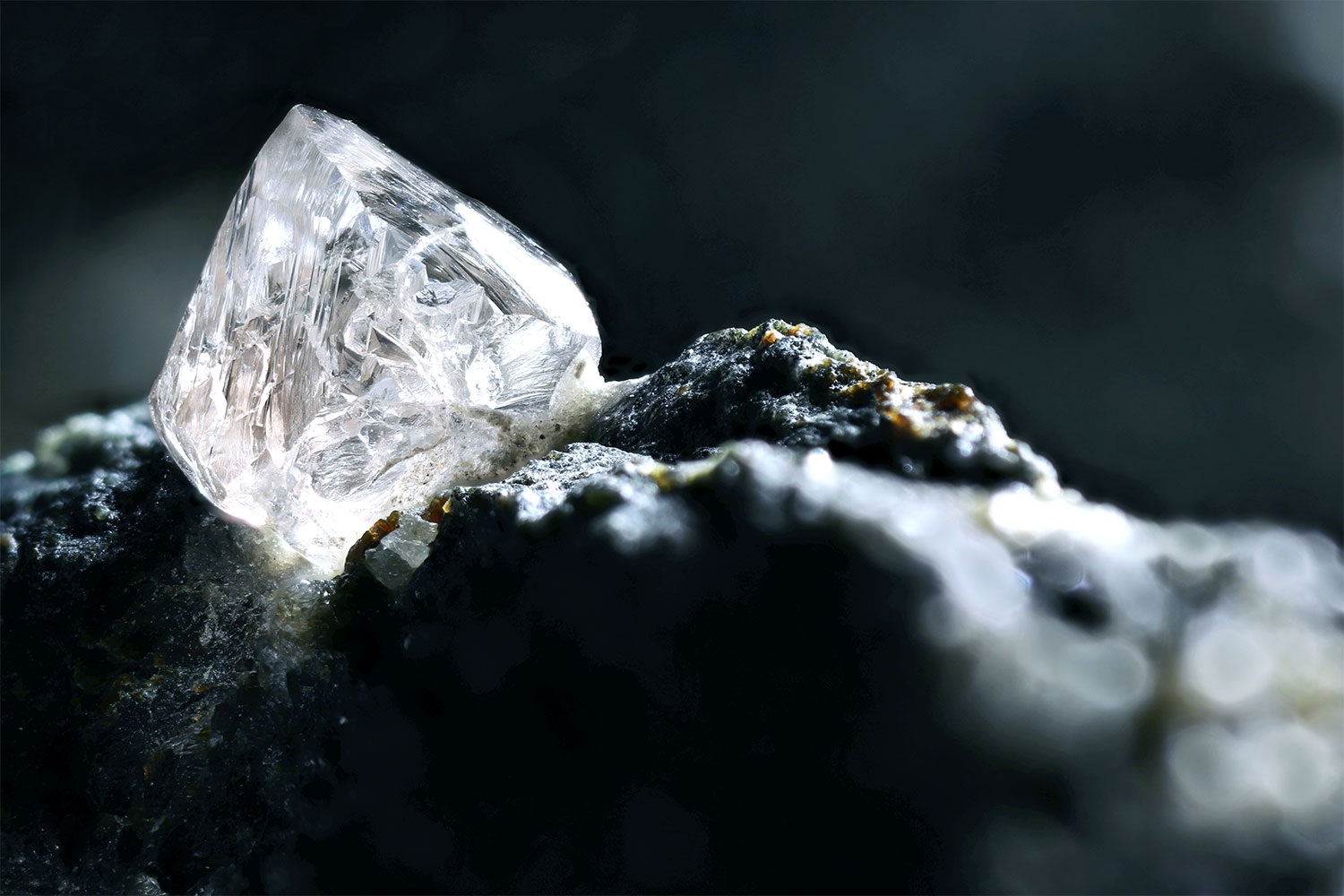
What does it look like under the ground where we are standing? The movie Journey to the Center of the Earth answers this question with an interesting imagination. The world deep inside the earth is depicted as a mysterious place where giant animals run around in a valley, hungry piranhas fill the ocean, and rocks float in the air by a strong magnetic field. Let’s have a journey to the center of the earth, an unknown world where no one has ever visited.
Internal structure of the earth, the world under our feet
The farthest distance the humans have ever reached is the moon, an average of 384,400 km [238,855 miles] away. Voyager 1, the furthest space probe in space from the earth among the objects made by humans, is travelling about 20 billion kilometers [12.4 billion miles] away from the earth. In this age when human beings are stretching their hands toward space, the depth we have gone toward the center of the earth through the surface of the earth is only 13 km [8 miles], which can be paradoxical. Considering that the earth’s radius is about 6,400 km [3.9 miles], we have not even peeled the earth’s skin.
Due to the extremely high pressure and temperature inside the earth, there is a limit to the depth of human reach. However, just as the inside of the human body can be seen through X-rays or ultrasonic waves, the internal structure of the earth can be seen by analyzing seismic waves which travel through the earth’s layers and which are a result of earthquakes that give out vibration.
There are P-waves and S-waves in seismic waves which contain the information about the interior of the earth. S-waves can only pass through solid materials, whereas P-waves can pass through almost any material. While a seismic wave is transmitted, its propagation velocity changes suddenly at the interface when it hits a layer with a different material. How many layers the inside of the earth is made of has been known through such characteristics of seismic waves.

In 1909, Andrija Mohorovicic, a Croatian seismologist, discovered a spot where the velocity of a seismic wave had a rapid increase tens of kilometers below the earth’s surface, which meant that the interior of the earth was made of different materials. Today, the boundary between the crust and the mantle is called the Mohorovicic Discontinuity after his name. In 1914, Beno Gutenberg, a German-American seismologist, discovered the boundary between the mantle and the core. In 1936, Danish seismologist Inge Lehmann discovered the inner core of the earth.
There is no mysterious space inside the earth where rare animals live, but it was discovered that the interior of the earth is divided into layers like an egg which is made of a yolk, an egg white, and a shell. At the center of the earth, which is like a yolk, lies a heavy core with a radius of about 3,500 km [2,175 miles], which is divided into the solid inner core and the liquid outer core. The temperature of the inner core is estimated to be over 5,000°C [9,000°F]. The 2,900 km [1,900 mile]-thick mantle surrounds the core, like an egg white. The relatively light crust floats on the earth’s surface, which is like a shell. There are two types of crusts: continental crust with an average thickness of about 35 km [22 miles] and oceanic crust with a thickness of about 5 km [3.1 miles].
Plate tectonics: the earth is moving
The land does not seem to move at all, but it’s actually moving slowly. These movements of the earth cause earthquakes and volcanic activities that terrorize us. However, the scientists who thought the earth was an immobile solid could not give a proper explanation about diastrophism for a long time. It was not until the 1960s that plate tectonics was suggested. It’s a theory that the earth’s outer shell is not made up of a single piece, but of more than ten small and big pieces like puzzle pieces that glide. Humans began to have a new perspective on the earth.

The pieces on the surface of the earth are called plates, the rigid lithosphere that has the thickness of about 100 km [62 miles] and comprises the earth’s crust and the uppermost mantle. The force that drives these huge plates is the mantle which moves deep under the earth’s surface. Beneath the plate is the asthenosphere, part of the mantle that has melted by the heat from the earth’s interior and become semifluid like sticky jelly. This asthenosphere moves the floating plates through convection.
The tectonic plates moves only a few centimeters per year, the speed at which a person’s nails grow. On a timescale of millions of years, however, the giant plates move as if a conveyor belt moves. Just as a growth ring is added to a tree every year, the mantle which is like the earth’s bare skin comes out and forms new plates, and the old plates that are pushed down melt and reused as mantle, thus circulating rocks. Mountain ranges are formed where plates collide with each other, and valleys or oceans are formed where plates drift apart from each other, and sometimes earthquakes occur at the plate boundaries.
Other terrestrial planets and the moon, too, have undergone changes since their formation, but the earth can be nicknamed a living planet as it is still experiencing changes.
Internal power that maintain the earth
The earth’s climate system is controlled by the material circulation between the atmosphere, hydrosphere, biosphere, and geosphere. The movement of the plates is an important component of the earth’s temperature control system as it circulates carbon dioxide, a greenhouse gas. The volcanic eruption releases carbon from the rocks that are the main reservoir of carbon into the earth’s atmosphere in the form of carbon dioxide, and the carbon dioxide in the atmospheric dissolves in the water or becomes sedimentary rocks at the bottom of the ocean and goes back into the inside of the earth.
Scientists assume that the earth’s magnetic field, which is an indispensable protective film and shield for living organisms, is also created inside the earth: When convection occurs in the outer core, a liquid layer that is mainly made up of iron and nickel, it generates electric currents like a running generator; and just as a magnetic field is created around a current-carrying conductor, currents from the outer core can produce the earth’s magnetic field.

Minerals and energy resources that are essential to our existence also exist inside the earth. Underground resources are widely used in our daily lives and industrial activities. Mineral resources have become part of our life; most of our daily necessities such as cell phones, computers, cars, airplanes, ceramics, cosmetics, and medicines contain minerals. The place where minerals useful for human life are concentrated in the crust is called mineral deposit. It is a result of the plate movement that occurs at the boundaries where the plates collide or separate. Thanks to volcanic activities, metamorphism, and magmatism that occur at the plate boundaries, the materials in the crust form new compounds, or change, or produce various kinds of minerals as certain components are enriched. Many mineral deposits are found in the boundaries of the plates that some people even call them the breadbasket of mineral resources. Fossil fuels such as coal and oil are formed when high pressure and heat are applied to the remains of animals and plants buried in the crust for a long time.
The abundance of minerals and energy resources, which brought the benefits of civilization to mankind, is from within the earth. Although we don’t usually feel the power of the internal earth, it is actually controlling human societies.
The earth is a lively place with living things. It is the only planet with the plate movement in the Solar System. The earth is not a simple collection of rocks. It moves constantly like a living organism. The surface of the earth appears to be solid and unchanging, but it changes continually, opening and closing the sea, and building mountains.
Convection inside the earth is like a heartbeat. It transfers its internal energy out. This energy is the starting point that keeps the earth living and moving. Another secret that makes the earth a living planet is found inside the earth. The constant movement of the earth forms a perfect ecosystem. The internal world of the earth has stimulated many people’s imagination. It is indeed filled with such mysterious power of life.
“There is a mine for silver and a place where gold is refined. Iron is taken from the earth, and copper is smelted from ore. Man puts an end to the darkness; he searches the farthest recesses for ore in the blackest darkness. Far from where people dwell he cuts a shaft, in places forgotten by the foot of man; far from men he dangles and sways. The earth, from which food comes, is transformed below as by fire;”Job 28:1–5
- Reference
- EBS Science Revolution Milestone Production Team, Homo Science 1, Knowledge Channel, 2013
- Park Dong-gon, Please Take Care of the Earth (In Korean, 지구를 부탁해), Science Books, 2011
- Jeffrey O. Bennett and three others, The Essential Cosmic Perspective, Seventh edition, Pearson, 2014
- John P. Grotzinger and Thomas H. Jordan, Understanding Earth, Seventh edition, W. H. Freeman, 2014